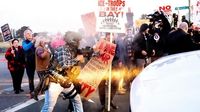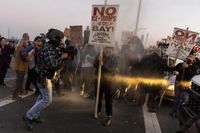In a dramatic turn of events that unfolded across the Bay Area this week, President Donald Trump abruptly called off a planned surge of federal immigration agents into San Francisco, a move that had sparked widespread protests, confusion, and political maneuvering across city and state lines.
The controversy began early on the morning of October 23, 2025, as federal agents—primarily from U.S. Customs and Border Protection—arrived at Coast Guard Island in Alameda, California. According to ABC News, hundreds of protesters gathered outside the Coast Guard station, determined to block a convoy of federal agents from entering the base. Demonstrators, some singing hymns and carrying signs that read “Protect our neighbors” and “No ICE or troops in the Bay,” were met by dozens of California Highway Patrol officers in riot gear. The standoff escalated when Coast Guard security forces deployed two flash bangs into the crowd, resulting in two protesters being injured—one with a foot run over and another struck by a flash bang. Two individuals were detained and taken away by authorities.
“The blood is from whatever I was shot with. I came to say we're here in peace, they didn't care,” said Pastor Jorge Bautista from the United Church of Christ in Oakland during the demonstration, as reported by KGO. Another protester, Tasha from Oakland, declared, “I'm here to let ICE know they're not welcome and that we will resist using a small fraction of the resistance; we will not stop, this is unconstitutional.”
The federal agents’ exact mission remained shrouded in uncertainty. ABC News confirmed only that the agents were in the Bay Area as part of an “immigration surge operation.” The lack of clarity added fuel to the anxiety already simmering among immigrant communities and their allies. “All these people are out here showing love for communities. I'm the child of immigrants. I had to come and be here for them; they can't come out for safety reasons, so I'll come out for them,” said demonstrator Nelson Colindres.
As the protests raged, political leaders scrambled to respond. President Trump had previously threatened to send the National Guard to San Francisco to address what he described as rampant crime, despite city officials pointing to data showing crime rates were actually declining. In a series of communications on October 22 and 23, Trump spoke with Mayor Daniel Lurie and prominent business figures, including Salesforce CEO Marc Benioff and Nvidia CEO Jensen Huang. The president later posted on Truth Social: “The Federal Government was preparing to ‘surge’ San Francisco, California, on Saturday, but friends of mine who live in the area called last night to ask me not to go forward with the surge. I spoke to Mayor Lurie last night and he asked, very nicely, that I give him a chance to see if he can turn it around.”
Mayor Lurie, in a statement shared with KGO and other outlets, emphasized the city’s progress and the importance of local control. “We appreciate that the president understands that we are the global hub for technology, and when San Francisco is strong, our country is strong,” Lurie said. “In that conversation, the president told me clearly that he was calling off any plans for a federal deployment in San Francisco. Secretary of Homeland Security Kristi Noem reaffirmed that direction in our conversation this morning. My team will continue to monitor the situation closely, and our city remains prepared for any scenario.”
The decision to halt the surge was not without political context. Governor Gavin Newsom’s office responded on X, “Trump has finally, for once, listened to reason — and heard what we have been saying from the beginning. The Bay Area is a shining example of what makes California so special, and any attempt to erode our progress would damage the work we’ve done.” Speaker Emerita Nancy Pelosi also weighed in, stating, “Mayor Daniel Lurie has demonstrated exceptional leadership in his steadfast commitment to the safety and well-being of San Franciscans. In his handling of a potential federal deployment in our City that resulted in the President calling off the operation, Mayor Lurie has underscored that public safety must be driven by local priorities, respectful of our values and communities.”
Despite the president’s announcement, confusion lingered throughout the Bay Area. According to The New York Times, it was not immediately clear whether the Trump administration had called off the entire planned U.S. Customs and Border Protection operation for all of the Bay Area, or just for San Francisco. Mayor Lurie clarified, “He only spoke about San Francisco.” In Alameda County, local leaders like District Attorney Ursula Jones Dickson expressed ongoing concern: “We know they’re baiting Oakland, and that’s why San Francisco all of a sudden is off the table. I’m not going to be quiet about what’s coming.” Oakland’s Mayor Barbara Lee echoed the uncertainty, saying, “We have no idea. This is very fluid. We are moving forward with our plans, and we are prepared.”
The confusion was evident among protesters as well. As word spread that Trump had called off the surge in San Francisco, a cheer went up outside Coast Guard Island, only to be replaced by uncertainty over whether the entire Bay Area had been spared. By late afternoon, California Highway Patrol officers had cleared the way for traffic, and the crowd had thinned. Protesters, undeterred, continued to voice their opposition, with some playing “The Imperial March” from “Star Wars” as a tongue-in-cheek commentary on the heavy police presence.
Legal experts noted that ongoing litigation in the U.S. Court of Appeals for the Ninth Circuit, based in San Francisco, may have influenced the president’s decision. The court is currently weighing appeals involving Trump’s previous use of the National Guard to augment immigration enforcement in cities like Los Angeles and Portland.
Amid the political and legal wrangling, the human impact was palpable. In San Francisco’s Mission District, a center of Latino culture, buses were nearly empty and school attendance dropped as families kept children home out of fear. “There’s a great deal of anxiety, stress and confusion,” said Cassondra Curiel, president of the local teachers union. After hearing the news that federal agents would not be coming to San Francisco, she described it as “a small relief,” but hoped the reprieve would extend to the entire Bay Area, not just the city.
San Francisco’s estimated undocumented population is about 42,000 out of more than 800,000 residents, according to a 2023 Migration Policy Institute analysis. Alameda County, by comparison, is home to roughly 100,000 undocumented immigrants, while Los Angeles County counts more than a million.
As the dust settled, city leaders, activists, and residents remained vigilant. Mayor Lurie pledged ongoing preparedness: “Our city remains prepared for any scenario. We have a plan in place that can be activated at any moment,” he said, adding, “it is my sincere hope that we never have to put that planning into action.”
This week’s events underscored the tension between federal authority and local autonomy, the power of protest, and the profound uncertainty facing immigrant communities in an era of shifting policies and political calculations.


